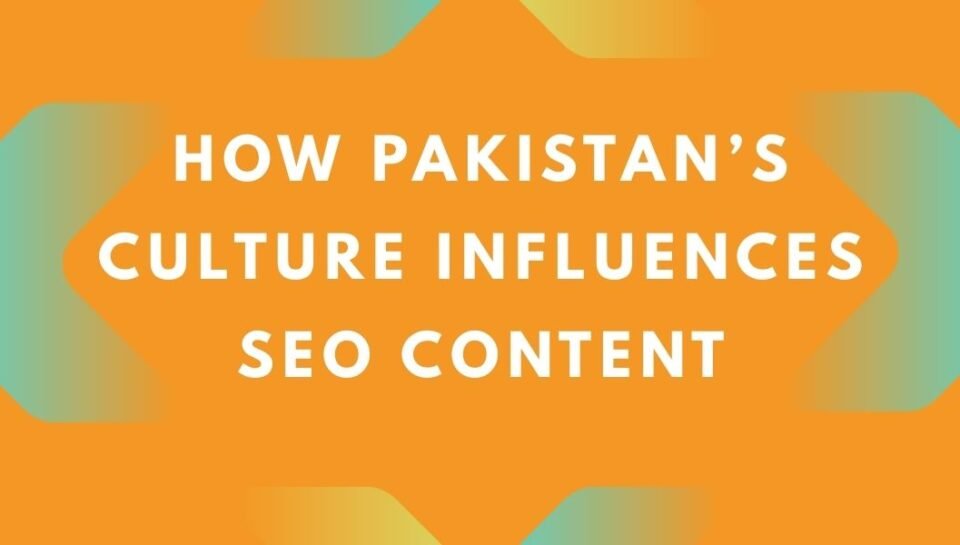
Pakistan’s digital audience is large, young, and mobile-first. With over a hundred million broadband connections and a majority accessing the internet via smartphones, search behavior here is shaped by language preferences, religious and social values, regional identities, and trust dynamics unique to the country. If you’re optimizing for Pakistan, treating SEO as “translation-only” leaves rankings, clicks, and conversions on the table. The right approach is cultural SEO—aligning search strategy to how Pakistanis actually search, read, trust, and buy.
Why Culture Matters for SEO in Pakistan
- Language realism: Users switch between English, Urdu, and Roman Urdu (Urdu written with Latin letters) in the same session. Queries like “sehri time Lahore,” “mobile price in Pakistan,” or “dua for anxiety in Urdu” are common patterns.
- Religious and social calendar: Traffic and intent shift dramatically around Ramadan, Eid, Muharram, Rabi’ al-awwal, Hajj, and major national events (e.g., Independence Day, PSL cricket season).
- Trust and risk: Preference for cash-on-delivery (COD), local reviews, and known marketplaces affects keyword choice, on-page elements, and conversion copy.
- Regional nuance: Karachi vs. Lahore vs. Peshawar searches differ by language, spellings, and even brand preferences.
Aligning to these cultural signals increases topical relevance, improves user signals (CTR, time on page), and boosts E-E-A-T—ultimately lifting rankings on SERPs.
Language: Urdu, Roman Urdu, and English Shape Queries and Content
What people actually type
- “price in Pakistan” + product name (e.g., “iPhone 15 price in Pakistan”)
- “meaning in Urdu” (e.g., “serendipity meaning in Urdu”)
- Religious intention queries (e.g., “dua for rizq in Urdu,” “taraweeh time today Lahore”)
- Services + “near me” in mixed language (e.g., “plumber near me Lahore,” “best nihari Karachi”)
- Exam and result keywords (e.g., “matric result 2025 date,” “FPSC jobs apply online”)
Actionable tactics
- Create pages that naturally mix English with Urdu or Roman Urdu phrases where appropriate, especially in FAQs and headings.
- Include synonym clusters with regional spellings: Gulshan-e-Iqbal / Gulshan e Iqbal; Sehri / Suhoor; Zakat / Sadaqah.
- Use transliteration variations in long-tail keywords: “talaq” / “talak,” “wazu” / “wudhu.”
- Add Urdu snippets for key terms in glossaries (e.g., a small definition box with اردو translation).
- Optimize for voice search: write question-style headings that mirror how users speak in Urdu/English code-switching.
Pro tip: For readability and crawlability, keep main body content in English or simple bilingual sections, and use FAQs to capture Roman Urdu queries without harming UX.
Religious and Social Values: Content Tone, Imagery, and CTAs
Pakistani audiences value modesty, family-centric messaging, and religious sensitivity. Copy and visuals that respect these norms drive higher trust and lower bounce rates.
On-page elements to tailor
- Imagery: Favor modest visuals; avoid suggestive imagery. Highlight family, community, and togetherness—particularly in food, fashion, and lifestyle niches.
- Microcopy: Use polite forms (“aap”) and supportive tone. Emphasize “original,” “authentic,” “halal,” “PTA approved” where relevant.
- Trust badges: Showcase local policies: COD, easy returns, local warranty, service center locations.
- Social proof: Testimonials with Pakistani names, cities, and ratings boost relevance.
- CSR and charity: Mention Zakat or Ramadan donations if genuine; integrate responsibly into brand storytelling.
Seasonality: Pakistan’s Cultural Calendar Drives Search Intent
Search volumes spike around religious months and national moments. Planning content calendars around these cycles increases topical authority and share of intent.
Key seasonal windows
- Ramadan and Eid: Recipes, prayer times, donation (Zakat), modest fashion, food delivery, grocery deals, electronics discounts, charity platforms.
- Wedding season (often Nov–Feb, post-Muharram): Bridal fashion, venues, caterers, photographers, makeup artists, gold rates.
- PSL and cricket tours: Match schedules, ticketing, live streaming, merchandise, TV packages, snack deals.
- Academic cycles: Matric/Intermediate results, university admissions, scholarships, test prep (FPSC, PPSC, CSS).
- National days and sales: 14 August, 23 March, 11.11 and 12.12 e-commerce sales, Eid sales, Independence Day offers.
Practical playbook
- Build evergreen hubs (e.g., “Ramadan Hub”) and refresh annually with dates, tables, and city-wise timings.
- Publish city-specific pages for high-intent queries: “Sehri/Iftar time Karachi today” and “Eid namaz timings Lahore.”
- Create price-tracking templates for electronics and gold exchange rates with schema to target rich snippets.
- Localize “Best of” lists during sale periods: “Best mobile under 50,000 in Pakistan (2025).”
Commerce and Trust: How Buying Behavior Influences Keywords and Conversions
Pakistani e-commerce has historically been COD-heavy, and users are price-sensitive. This shapes both queries and conversion optimization.
Keyword patterns to expect
- “price in Pakistan,” “official price,” “latest price,” “specs,” “installments,” “PTA approved.”
- “original vs copy,” “box pack,” “warranty claim,” “authentic,” “cash on delivery.”
- Brand + “daraz,” “olx,” “review in Urdu,” “unboxing,” “vs” comparisons.
On-page conversion levers
- Display “price in PKR,” installment options, and COD availability above the fold.
- Use comparison tables (“Model A vs Model B”) and add a “price history in Pakistan” mini-chart to capture informational + transactional intent.
- Feature local customer reviews and short Urdu/Roman Urdu snippets to improve relatability.
- Add WhatsApp click-to-chat; it’s a core trust and conversion channel in Pakistan.
- Publish service center locations, local phone numbers, and a “7-day easy return” badge.
Note: Even as digital payments grow, offering both COD and digital options keeps abandonment low.
Regionalization: City and Province Signals Matter
Pakistan’s provinces—Punjab, Sindh, Khyber Pakhtunkhwa, Balochistan, and regions like Gilgit-Baltistan—show varied language and search behaviors.
How to localize effectively
- Create city landing pages with authentic place names and spelling variations: “Gulberg III (Gulberg 3),” “Saddar,” “Hyderabad Sindh.”
- Include landmarks and neighborhood cues users recognize (near “Liberty Market,” “Dolmen Mall,” “Qissa Khwani Bazaar”).
- Offer multilingual support where relevant (Pashto, Sindhi, Punjabi phrases) in FAQs to capture long-tail.
- Use localized internal links (e.g., “AC repair in Lahore” linking to service areas within Lahore).
Platform Realities: Mobile-First, Video-Heavy, and Social SEO
Most users access the web via mobile data. Video platforms like YouTube and TikTok are discovery engines and influence SERPs.
Technical and content choices
- Performance: Lightweight pages, WebP images, deferred scripts, font subsetting, and server locations near Pakistan for faster TTFB.
- Video SEO: Publish YouTube videos in Urdu or bilingual format, embed on relevant pages, and add transcript sections to rank for “in Urdu” queries.
- Shorts/Reels: Repurpose blog snippets into vertical videos with localized hooks and captions; link back to long-form content.
- WhatsApp funnels: Add UTMs to WhatsApp links; treat them as bottom-funnel qualifiers.
E-E-A-T, Local Authority, and Backlinks in Pakistan
Demonstrating experience, expertise, authoritativeness, and trustworthiness requires local proof.
Signals that move the needle
- Author bios: Showcase local credentials and experience with Pakistani markets, regulations, or categories (e.g., SECP, FBR, PTA compliance insights).
- Local citations: Google Business Profile in Urdu and English; consistent NAP across Pakistani directories and industry forums.
- Backlinks: Earn mentions from reputable Pakistani publishers and communities (e.g., national newspapers, tech blogs, universities, chambers of commerce).
- Data and transparency: Publish localized stats, delivery SLAs by city, and return policies; include Urdu summaries.
Schema, Snippets, and SERP Features for Pakistan
Structured data and snippet strategy should reflect common Pakistani queries.
- Use Product, FAQ, and HowTo schema for price/spec pages; add “price in PKR” explicitly.
- Add Organization schema with WhatsApp and local phone as contact points.
- For religious content (e.g., prayer times), use structured tables and city-specific pages; consider FAQ schema for variant spellings (Sehri/Suhoor).
- Mark store availability by city with LocalBusiness schema for each branch.
Content Types That Perform Well in Pakistan
- Price + Specs Hubs: “Best phones under X PKR,” with filters, comparison charts, and links to “official price in Pakistan.”
- Meaning and Glossary Pages: English-to-Urdu meanings, Islamic terms, and law/finance terminology explained with examples.
- City Service Pages: Service + city + neighborhood variants, WhatsApp CTA, Urdu FAQ, and map embed.
- Ramadan Resource Pages: Sehri/Iftar times by city, recipes, charity guidance, and shopping checklists.
- Admission/Job Guides: Step-by-step for application portals, dates, document checklists, and fee tables.
- Cricket Guides: Schedules, ticket info, live stream options, and match-day offers.
Ethics and Sensitivity: Get It Right
- Represent religious content respectfully and accurately; cite sources when explaining religious matters.
- Avoid political stereotyping; focus on utility and neutrality for government-related guides.
- Use inclusive, modest visuals; obtain consent for testimonials and case studies.
- Disclose sponsorships; be transparent with pricing and promotions to build long-term trust.
Examples: Cultural SEO in Action
Example 1: Electronics Retailer
Goal: Rank for “Samsung A-series price in Pakistan” and convert mobile traffic.
- Page title: “Samsung A14 Price in Pakistan (2025) – Specs, PTA Approved, Installments”
- Above the fold: PKR price, “COD available,” “PTA approved,” EMI plan, WhatsApp chat.
- Body: Specs table, Urdu mini-glossary for features, price history chart, FAQs in Roman Urdu (warranty, box pack, original vs copy).
- Result: Higher CTR for “price in Pakistan,” improved time on page, and increased WhatsApp conversions.
Example 2: Ramadan Content Hub
Goal: Capture Ramadan informational traffic and support commerce.
- City pages: “Sehri and Iftar Time Karachi Today” with daily updates, alt spellings (Sehri/Suhoor).
- Related guides: Zakat calculator, Ramadan recipes, shopping lists with interlinks to grocery offers.
- Schema: FAQ for “What is Sehri time in Lahore today?” helps win rich snippets.
Example 3: Local Services
Goal: Rank for “AC repair near me Lahore.”
- Landing page per area: “AC Repair in Gulberg III – 24/7, WhatsApp Booking.”
- Content includes neighborhood landmarks, Urdu FAQs, reviews with Pakistani names.
- Google Business Profile in English + Urdu; photos and Q&A updated weekly.
Data Pointers to Guide Your Pakistan SEO
- Mobile-led usage: The vast majority of internet sessions originate from smartphones; optimize for low bandwidth and quick interactivity.
- Video-first discovery: YouTube and TikTok content frequently influences branded and product searches.
- COD preference: Cash-on-delivery remains a key trust mechanism; naming it explicitly can lift conversions.
- Language switching: Mixed English/Urdu and Roman Urdu queries are common; design content and FAQs to match.
Treat these as directional insights when choosing keywords, content formats, and conversion UX.
Workflow: How to Operationalize Culturally Aligned SEO
- Research: Pull Search Console queries; label by language (English/Urdu/Roman Urdu), season, and city.
- Cluster: Group “price in Pakistan,” “meaning in Urdu,” religious timings, and service + city long tails.
- Localize: Write bilingual headings/FAQs; include regional spellings and neighborhood cues.
- Build trust: Add COD, warranty, local numbers, WhatsApp, and store addresses with schema.
- Distribute: Repurpose into YouTube Shorts and TikTok with Urdu hooks; link back to the hub page.
- Measure: Track CTR for “price in Pakistan” pages, WhatsApp UTM conversions, and city-wise rankings.
- Iterate: Refresh seasonal hubs (Ramadan, PSL, Admissions) annually with updated dates and offers.
LSI and Semantic Keywords to Weave Naturally
Use variations to capture broader intent without keyword stuffing:
- Urdu SEO, Roman Urdu SEO, local SEO Pakistan, Pakistani audience insights
- Ramadan marketing, Eid campaign strategy, prayer times Pakistan
- Price in Pakistan, PTA approved, COD in Pakistan, warranty claim
- Cricket SEO, PSL schedule, live streaming Pakistan
- Admissions guide Pakistan, government jobs, FPSC/PPSC prep
- Google Business Profile Pakistan, WhatsApp conversions
Common Pitfalls to Avoid
- Direct translations without cultural context or Roman Urdu variants.
- Ignoring city-level intent and neighborhood spellings.
- Heavy images and scripts that slow mobile users on data plans.
- Generic trust signals without local proof (no COD, no local reviews, no Urdu support).
- One-off seasonal posts instead of evergreen hubs refreshed yearly.
Conclusion:
In Pakistan, culture isn’t a backdrop—it’s the roadmap to search success. When your content respects language realities (Urdu, Roman Urdu, and English), aligns with the religious and social calendar, reflects regional nuance, and addresses trust concerns (COD, warranty, authenticity), you earn better engagement and stronger rankings. Combine these cultural insights with solid technical SEO—fast pages, clean architecture, structured data—and you will consistently capture demand, win rich results, and convert more of your Pakistani audience.
Start by mapping your current queries to cultural patterns, build bilingual FAQs and city pages, and create evergreen seasonal hubs you can refresh every year. The result is SEO that feels native, useful, and trustworthy—because it’s built for how Pakistan searches and buys.




